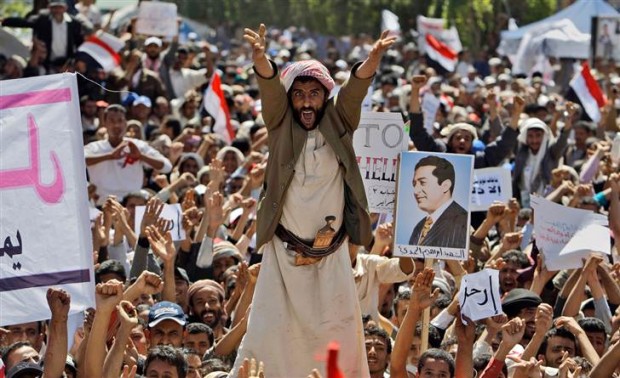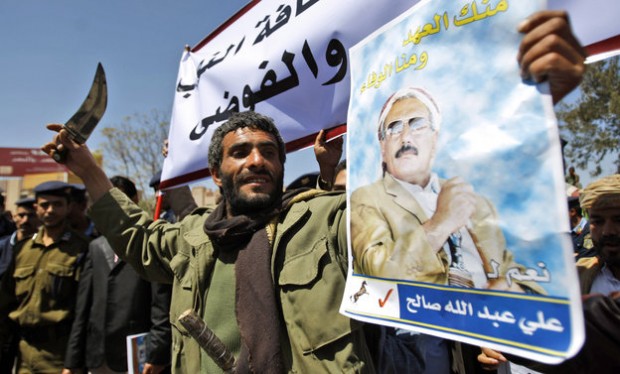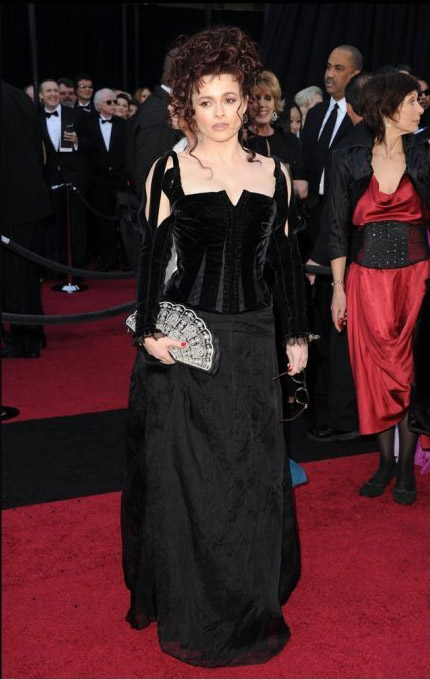Notes
The Arab Lens: Friendly/Good vs. Scary/Bad

Two weeks ago, just three days after Mubarak fell, someone who follows the newswires very closely sent me a photo from Yemen of a protester waving a dagger in front of a poster of President Ali Abdullah Saleh with the comment:
“The gold standard Arab image … we’re more comfy with this, I guess.”
The photo not only stayed in my head but came to mind again today when the photo above — of a wild-eyed anti-government Yemeni protester with a dagger in his belt on a “Day of Rage” — was featured on Tuesday’s photo gallery on the NYT Lens blog, in a Middle East photo gallery at MSNBC, and several other places.
On his ever insightful blog a couple weeks ago, visual analyst David Campbell wrote about the limitations of the visual coverage of the Egypt uprising. Besides geographic limits (most photos originating from Cairo’s Tahrir Square), David cited International Studies scholar Paul Amar for breaking down the media coverage of the Egypt uprising into three general “binaries,” including, “People vs. Dictatorship,” “Seculars versus Islamists” and “Old Guard vs. Frustrated Youth.”
Looking toward our next BagNewsSalon — schedule for March 20th and slated to examine the visual framing of the 18 day Egyptian uprising (and yes, David will be joining us) — I’ve been thinking about other ways the photo coverage of the Middle East can be classified in this two-fold manner, especially since Mubarak fell.
At the most basic level,though, Amar emphasizes how the media tends to reduce complex international events into “good guys versus bad guys,” this first-order binary helping to explain why the Yemeni shot I linked to above — after the intoxication of the Egyptian revolution — seemed to catch me off guard, and why today’s photo doesn’t just bother me, but actually unnerves me.
As I’ve touched on in a couple posts already (1, 2) — to the extent the democracy-seeking Arabs tend to look like us and do their revolution-making in peaceable and prettified ways, we love them and love to look at them. On the other hand, though, to the extent “they” start to look more angry, more violent, and either more religious or more tribal, than the instinctual breakdown Western visual media tends to make is simply friendly/safe/good versus scary/threatening/bad.
(photo 1: Muhammed Muheisen / AP. caption: An anti-government protester reacts during a demonstration demanding the resignation of President Ali Abdullah Saleh in Sanaa, Yemen, on Tuesday, March 1. Tens of thousands of protesters flooded Yemen’s streets on Tuesday, dedicating a fresh “Day of Rage” to the 24 people killed in demonstrations demanding an end to the Saleh’s three-decade rule. photo 2: Hani Mohammed/AP. caption: A supporters of the Yemeni government holds a poster of President Ali Abdullah Saleh and waves a dagger during a clash with anti-government demonstrators, unseen, in Sanaa, Yemen, Monday, Feb. 14, 2011. More than 1,000 people protested in Yemen for a fourth straight day Monday, demanding political reforms and the ouster of the U.S.-allied president in demonstrations inspired by the upheaval in Egypt.)



Reactions
Comments Powered by Disqus